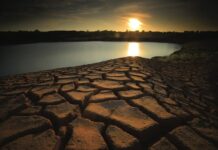One can’t go a single day without hearing about the four-year drought in California.
Sure, the state has experienced seven multiyear droughts during the last century, but this is the driest four-year stretch the Golden State has seen since 1895. And its major metropolitan areas, including San Francisco, Los Angeles, Sacramento and Fresno, logged their driest years ever recorded right in the middle of it in 2013.
But Americans—not just Californians—should be concerned … and not just because Californians produce nearly half of U.S.-grown fruits, vegetables and nuts. According to a Government Accountability Office (GAO) survey, 40 states in the U.S. are expected to experience water shortages within the coming decade—even under what it describes as “average” conditions. But how often do conditions remain “average?” Imagine if those conditions change due to rapid population growth, unusually low snowfall or rainfall, or accelerated economic growth. The situation could worsen.
“As far as other states,” insists Ben Chou, a water policy analyst in the Los Angeles office of the Natural Resources Defense Council, in a recent Huffington Post article, “if they haven’t seen it in the past, it’s something they will see in the future.”
West and South: Where the water problems start
Let’s start at the root of the problem in the West.
Approximately 62 percent of western U.S.-based landscape professionals answering the Turf survey say water conservation is a huge issue that everyone is talking about. Another 20 percent say it’s a growing issue and another 18 percent say some clients are concerned. Zero percent of landscapers in the West say water is not an issue.
Water is certainly a concern in Utah, which is experiencing drought conditions. Russell Clegg, lead watermaster at Utah Valley University in Orem, Utah, manages irrigation systems that are 20 years old. The university has been able to upgrade 70 percent of them, but money is tight, so irrigation system improvements are happening slowly. Luckily, the area is growing, so money is trickling in for these repairs. But “water is limited,” Clegg explains. “People will have to conserve or they will do without.”
Xeriscaping and hardscaping are also becoming much more prevalent in the area, and will continue to do so, Clegg says. “You have to plant correctly or you are just wasting money,” he says.
Massive changes are happening in western landscapes as a result of drought, the Turf survey says. Seventy-one percent of landscapers say clients are reducing lawn areas or removing turf in an effort to conserve water. Approximately 63 percent of western landscape clients are using more native/or regionally adapted plants and 58 percent are updating their irrigation systems to be smarter and more efficient.
A little further east and in the southern region of the country (as part of the Turf survey) in Oklahoma, Tulsa Landscape’s customers aren’t experiencing a drought, but the city’s political officials are using nearby drought conditions in Oklahoma City, as well as California’s drought challenges, as reasons to continue to raise water rates. Water costs have increased 80 percent over the past nine years. “But they are doing it more for political reasons—to balance the budget,” explains David Land, Tulsa Landscape, Tulsa, Oklahoma. “They are pricing water higher and, sure, that will force water savings, but that’s not the reason they are doing it.”
Land spends a good chunk of his time assessing existing irrigation systems on his customers’ properties and recommending upgrades. Because many of the systems installed were done on the cheap as an afterthought on newly built homes where the majority of the money was spent on the interiors and leftover cash was sparingly used on landscape irrigation, most systems need an upgrade after roughly three years. Land’s minimum ticket on an irrigation repair is $500 to $1,000. The biggest problem he sees is a lack of good coverage, where inexpensive and inferior irrigation heads were used or irrigation heads were spaced too far apart to save money.
The good news, though, is that more of Land’s customers are willing to spend money on smart irrigation upgrades, including smart controllers, smartphone-controllable controllers, more efficient rotators and drip irrigation. Land has a harder time selling rain and freeze sensors though. “Usually, if I can show people the cost savings of upgrading, then they will go through with it,” Land says. “They usually don’t do so just for water savings.”
The problem with poorly installed irrigation systems is they need frequent and costly repairs, Land says. On the other hand, a well-installed system from the start may cost approximately 30 percent more up front, but only need less than $1,000 in repairs at around the 10- or 11-year mark versus more costly repairs needed every three years on a poorly designed system.
While the majority of landscape company clients in the South have irrigation systems, 78 percent of them are outdated and could use upgrades, according to landscapers answering the Turf survey.
This is only 1 percentage point less than the entire country average of 79 percent of clients with outdated irrigation systems. So while the West and South may be leading the way in terms of smarter, water-saving upgrades, the central and northeast regions are suffering the same problems with archaic systems, but the landscapers in these regions are much further behind when it comes to convincing their clients to save water and money by modernizing their systems.
Middle of the country: Room for improvement
Traveling east to the Midwest, water conservation is not an issue for 56 percent of residents, according to landscapers answering the Turf survey, but 34 percent of their clients are concerned about water. Most landscape clients (57 percent) also are not requesting or making any changes in an effort to conserve water. Furthermore, a smaller percentage of landscape clients have irrigation systems, and of those who do, 77 percent have older yet functional systems that could use upgrades. Despite the state of their systems, most clients (50 percent) believe their systems work fine the way they are. And when it comes to suggestions on making their systems better, most (37 percent) say, “Give me the cost and I’ll get back to you.”
Despite an abundance of water, costs are escalating in Indiana, according to Bill McDonald, owner of Field of Dreams Lawn Care, based in Cumberland. Why? A very old sewer and rainwater system combination that was built in the first half of the 1900s has caused water contamination issues. The area is building a billion-dollar solution in the form of an underground tunnel to hold the sewage and prevent overflow into local creeks and rivers. Residents are helping to pay for it through increasing water rates.
“Our water bills used to be ridiculously cheap—like $20 a month,” McDonald says. “Now they are up to $40, and if we use a lot of water, bills could reach above $60 a month.”
And Indiana isn’t the only state that, despite a lack of drought, is still experiencing water-related challenges. In the decade following World War II, America’s cities, resurgent from an economic depression, installed and expanded the far-reaching water supply networks that propelled a generation of widespread economic growth, prosperity and improvement in public health, says Brett Walton in Circle of Blue’s “Price of Water 2015 Report.” This was followed by facilities to cleanse the nation’s waterways of harmful pollutants and organic wastes in the 1970s.
But those thousands of miles of distribution pipes beneath city streets are now suffering from cracks as a result of wear. Some estimate the national cost of repairing and replacing old pipes at more than $1 trillion over the next two decades. “The bill to repair and renew America’s long-neglected water systems is coming due,” Walton says.
Continuing a trend that shows no sign of slowing, the price of residential water service in 30 major U.S. cities rose faster than the cost of nearly every other household staple last year, according to Circle of Blue’s survey. The average monthly cost of water for a family of four using 100 gallons per person per day climbed 6 percent in 2015 over 2014—or 41 percent since 2010, according to utilities data. The median increase this year was 4.5 percent.
While water costs have increased, it’s not enough to inspire anyone to use less water in the central region, McDonald says. “People grumble, but they aren’t changing their habits,” McDonald says. “Here, we are absolutely wasting water. But it’s hard to waste a resource you’re ankle deep in. The water table here is high. Yet, we’re a whole bunch of water hogs here in the Midwest.”
Steve Ray, owner of Minnesota-based Sunrise Sprinkler & Landscape Lighting, agrees. “We try to tell customers not to water too much, but it falls on deaf ears most of the time,” he says. “There’s no drought in my area but it’s been dry. City water costs vary quite a bit. There are no real water restrictions at this point—only recommendations from time to time.”
The real issue is with the irrigation systems. “I can still drive by a property and see a malfunctioning irrigation head shooting water into the street,” McDonald says. “I have yet to come across a system that has sensors. Here, irrigation systems are a luxury. It’s a nice thing to have. We get plenty of rain, so people feel they don’t have to have one … or don’t have to fix one that’s broken.”
Ray is in the same boat. “We see more set-it-and-forget-it setups,” he says. “We get a lot of calls from them after the lawns change color.”
The East Coast is not immune
And don’t think the East Coast is immune. While water problems are the worst in the West, the GAO report listed North Carolina and Delaware as the eastern states most likely to experience regional water shortages in the next decade. Drought certainly doesn’t happen overnight; it can creep up on an area.
When water is a concern, where do regulations hit first? The landscape. Outdoor irrigation makes up 44 percent of California’s urban and suburban community water use, according to the state water board. Mandatory water conservation rules so far include a ban on watering lawns and landscapes within 48 hours of measurable rain and municipalities and private companies must limit lawn watering to two days per week—not to mention limiting lawns to 25 percent of a home’s yard, rewarding those who replace lawns with more drought-tolerant plants, and not fining those who let their lawns go brown.
Yes, attention is on California due to its size, but other states are taking note. Rising water rates and water regulations are already impacting landscape contractors in states where water supplies are at a premium, and others also expect it to soon become a challenge. Nationally, 70 percent of landscape professionals answering Turf’s survey see water becoming an issue in their region, even if it’s not an issue now.
In fact, here’s where it gets interesting—89 percent of those in the West feel that even if water isn’t an issue in their region it will become an issue as drought conditions worsen, along with 74 percent in the South, 54 percent in the Central region and 69 percent in the Northeast. (Yes, 69 percent in the region where currently 0 percent of people feel water is currently a problem.)
Continued population growth and changing weather patterns are expected to leave more areas of the country more vulnerable to serious droughts and water issues in the future.
As McDonald says, “People can certainly learn to live with a lot less water.”
Read more:











![[VIDEO] Dickies®: Discover Workwear That’s Anything But Uniform](https://turfmagazine.com/wp-content/uploads/2023/06/1647663814-4b1a2a7742790a9b1e97a3b963477850192e1d6a9dfba9b07214a77bae25d6e3-d-218x150.jpg)





























![[VIDEO] Dickies®: Discover Workwear That’s Anything But Uniform](https://turfmagazine.com/wp-content/uploads/2023/06/1647663814-4b1a2a7742790a9b1e97a3b963477850192e1d6a9dfba9b07214a77bae25d6e3-d-324x160.jpg)